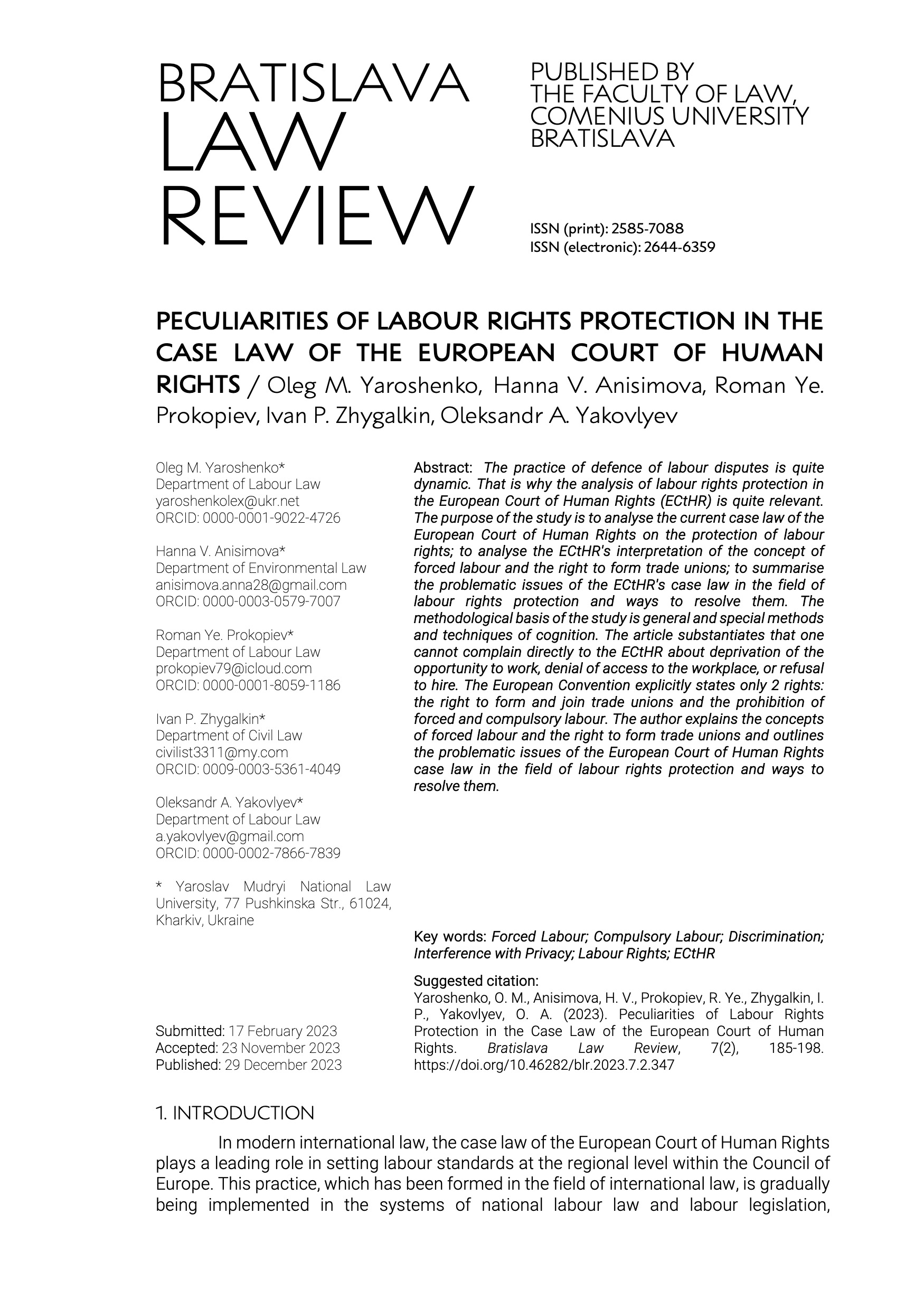Peculiarities of Labour Rights Protection in the Case Law of the European Court of Human Rights
DOI:
https://doi.org/10.46282/blr.2023.7.2.347Keywords:
Forced Labour, Compulsory Labour, Discrimination, Interference with Privacy, Labour Rights, ECtHRAbstract
The practice of defence of labour disputes is quite dynamic. That is why the analysis of labour rights protection in the European Court of Human Rights (ECtHR) is quite relevant. The purpose of the study is to analyse the current case law of the European Court of Human Rights on the protection of labour rights; to analyse the ECtHR's interpretation of the concept of forced labour and the right to form trade unions; to summarise the problematic issues of the ECtHR's case law in the field of labour rights protection and ways to resolve them. The methodological basis of the study is general and special methods and techniques of cognition. The article substantiates that one cannot complain directly to the ECtHR about deprivation of the opportunity to work, denial of access to the workplace, or refusal to hire. The European Convention explicitly states only 2 rights: the right to form and join trade unions and the prohibition of forced and compulsory labour. The author explains the concepts of forced labour and the right to form trade unions and outlines the problematic issues of the European Court of Human Rights case law in the field of labour rights protection and ways to resolve them.
References
Bakhanov, O. (2020). Protection of social workers during the Covid-19 pandemic. Bulletin of NTUU “KPI”. Politology. Sociology. Law, 47(3), 20-28. DOI: https://doi.org/10.20535/2308-5053.2020.3(47).227028 DOI: https://doi.org/10.20535/2308-5053.2020.3(47).227028
Chernetska, O. and Andriichenko, O. (2019). The case law of the European Court of Human Rights in the administration of justice. Enterprise, Economy and Law, 4/2019, 284-288.
Gnatenko, K. V., Yaroshenko, O. M., Anisimova, H. V., Shabanova, S. O. and Sliusar, A. M. (2020). Prohibition of discrimination as a principle of social security in the context of ensuring sustainable well-being. Rivista Di Studi Sulla Sostenibilita, (2), 173-187.
Hetmantseva, N. (2016). The concept and essence of labor as a legal category. Entrepreneurship, Economy and Law, 7/2016, 60-65.
Konopeltseva, O. (2017). Prohibition of forced labor as a principle of labor law. Law and Innovation, 18(2), 98-104.
Kovalenko, O. (2016). Actual problems of modern understanding of the right to work. Scientific collection of Khmelnytsky University of Management and Law “University Scientific Notes”, No. 59, 39-51.
Kolben, К. (2010). Labor rights as human rights? Virginia Journal of International Law, 50(2), 449-484.
Mantouvalou, V. (2014). The protection of the right to work through the European Convention on Human Rights. Cambridge Yearbook of European Legal Studies, 16, 313-332. DOI: https://doi.org/10.1017/S1528887000002639 DOI: https://doi.org/10.1017/S1528887000002639
Lörcher, K. and Schömann, I. (2013). The European Convention on Human Rights and the employment relation. Hart Publishing.
Lutkovskaya, B. (2005). The European Court of Human Rights: organization, activities, process. Praxis.
Merrills, J. G. and Robertson A. H. (2022). Human rights in Europe: A study of the European Convention on Human Rights. Manchester University Press. DOI: https://doi.org/10.7765/9781526170590
Pudzianowska, D. and Korzec, P. (2020). Human rights and the protection of stateless persons in the case law of the European Court of Human Rights. Polish Yearbook of International Law, 40, 179-195. DOI: https://doi.org/10.24425/pyil.2021.138435
Sauer, H. (2019). Principled Resistance to and Principled Compliance with ECtHR Judgments in Germany. In: Breuer, M. (ed.), Principled Resistance to ECtHR Judgments-A New Paradigm (pp. 55–87). Berlin, Heidelberg: Springer. DOI: https://doi.org/10.1007/978-3-662-58986-1_3 DOI: https://doi.org/10.1007/978-3-662-58986-1_3
Schmahl, S. (2022). The European Court of Human Rights — Can there be too much Success? A Comment. Journal of Human Rights Practice, 14(1), 191-203. DOI: https://doi.org/10.1093/jhuman/huac024 DOI: https://doi.org/10.1093/jhuman/huac024
Sicilianos, L. A. (2020). The European Convention on Human Rights at 70: the dynamic of a unique international instrument. Available at: https://www.echr.coe.int/documents/d/echr/Speech_20200505_Sicilianos_70th_anniversary_Convention_ENG (accessed on 15 March 2022). DOI: https://doi.org/10.1017/9781839701139.002
Sychenko, E. (2019). Contribution of the European Court of Human Rights to the understanding of human rights at work. Journal of the Higher School of Economics, No. 5, 54-79. DOI: 10.17323/2072-8166.2019.5.54.79 DOI: https://doi.org/10.17323/2072-8166.2019.5.54.79
Sychenko, E. and Chernyaeva, D. (2019). The impact of the ECHR on employee’s privacy protection. Italian Labour Law e-Journal, 12(2), 171-188. DOI: https://doi.org/10.6092/issn.1561-8048/10015
Sychenko, E. and Perulli, A. (2023). Employment Law and the European Convention on Human Rights: The Research of the Recent Jurisprudence of the ECtHR Related to Employment Law’ (2017-2021). Kluwer Law International BV.
Yaroshenko, O. (2016). The main directions of establishing the principles of the welfare state in labor law. Law and Innovation, 13(1), 23-29.
Yaroshenko, O. M., Kutomanov, D. Y., Maryniv, N. A. and Dudenko, T. V. (2020a). Features of corporate liability for violation of competition law. International Journal of Criminology and Sociology, 9, 1517-1525. DOI: https://doi.org/10.6000/1929-4409.2020.09.172 DOI: https://doi.org/10.6000/1929-4409.2020.09.172
Yaroshenko, O. M., Vapnyarchuk, N. M., Burnyagina, Y. М., Kozachok-Trush, N. V. and Mohilevskyi, L. V. (2020b). Professional Development of Employees as the Way to Innovative Country Integration. Journal of Advanced Research in Law and Economics, 11(2), 683-695. DOI: https://doi.org/10.14505/arle.v11.2(48).39 DOI: https://doi.org/10.14505/arle.v11.2(48).39
Zuiderveen Borgesius F. J. (2020). Strengthening legal protection against discrimination by algorithms and artificial intelligence. The International Journal of Human Rights, 24(10), 1572-1593. DOI: https://doi.org/10.1080/13642987.2020.1743976 DOI: https://doi.org/10.1080/13642987.2020.1743976
Council of Europe. Convention for the Protection of Human Rights and Fundamental Freedoms. Council of Europe, 4 November 1950. Available at: https://www.echr.coe.int/documents/convention_eng.pdf (accessed on 15 March 2022).
ECtHR, Gorzelik and others v. Poland, app. no. 44158/98, 17 February 2004.
ECtHR, Popov v. Ukraine, app. no. 23892/03, 14 December 2006.
ECtHR, Vnuchko v. Ukraine, app. no. 1198/04, 14 December 2006.
ECtHR, Rantsev v. Cyprus and Russia, app. no. 25965/04, 7 July 2011
ECtHR, Stummer v. Austria, app. no. 37452/02, 7 July 2011.
ECtHR, Chitos v. Greece, app. no. 51637/12, 4 June 2015.
ECtHR, Chowdury and others v. Greece, app. no. 21884/15, 30 March 2017.

Downloads
Published
Issue
Section
Categories
License
Copyright (c) 2023 Bratislava Law Review

This work is licensed under a Creative Commons Attribution-NonCommercial-NoDerivatives 4.0 International License.
The Author(s) transfers copyright to the Article to the Publisher of the Journal by the Licence Agreement.
The Author(s) retains rights specified in the Licence Agreement.
The readers may read, download, copy, distribute, print, search, or link to the full texts of all of the Article of the Journal and use them for any other lawful purpose under specified Creative Commons Licence (CC BY-NC-ND 4.0).











